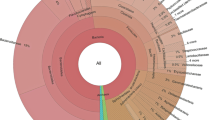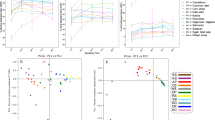Abstract
The rumen is a complex ecosystem enriched for microorganisms able to degrade biomass during the animal’s digestion process. The recovery of new enzymes from naturally evolved biomass-degrading microbial communities is a promising strategy to overcome the inefficient enzymatic plant destruction in industrial production of biofuels. In this context, this study aimed to describe the bacterial composition and functions in the sheep rumen microbiome, focusing on carbohydrate-active enzymes (CAE). Here, we used phylogenetic profiling analysis (inventory of 16S rRNA genes) combined with metagenomics to access the rumen microbiome of four sheep and explore its potential to identify fibrolytic enzymes. The bacterial community was dominated by Bacteroidetes and Firmicutes, followed by Proteobacteria. As observed for other ruminants, Prevotella was the dominant genus in the microbiome, comprising more than 30 % of the total bacterial community. Multivariate analysis of the phylogenetic profiling data and chemical parameters showed a positive correlation between the abundance of Prevotellaceae (Bacteroidetes phylum) and organic matter degradability. A negative correlation was observed between Succinivibrionaceae (Proteobacteria phylum) and methane production. An average of 2 % of the shotgun metagenomic reads was assigned to putative CAE when considering nine protein databases. In addition, assembled contigs allowed recognition of 67 putative partial CAE (NCBI-Refseq) representing 12 glycosyl hydrolase families (Pfam database). Overall, we identified a total of 28 lignocellulases, 22 amylases and 9 other putative CAE, showing the sheep rumen microbiome as a promising source of new fibrolytic enzymes.





Similar content being viewed by others
References
Asanuma N, Hino T (2000) Activity and properties of fumarate reductase in ruminal bacteria. J Gen Appl Microbiol 46:119–125
Bach A, Calsamiglia S, Stern MD (2005) Nitrogen metabolism in the rumen. J Dairy Sci 88:E9–E21
Blankenberg D, Gordon A, von Kuster G, Coraor N, Taylor J, Nekrutenko A, Team Galaxy (2010) Manipulation of FASTQ data with galaxy. Bioinformatics 26:1783–1785
Brulc JM, Antonopoulos DA, Miller MEB, Wilson MK, Yannarell AC, Dinsdale EA, Edwards RE, Frank ED, Emerson JB, Wacklin P, Coutinho PM, Henrissa B, Nelson KE, White BA (2009) Gene-centric metagenomics of the fiber-adherent bovine rumen microbiome reveals forage specific glycoside hydrolases. Proc Natl Acad Sci USA 106:1948–1953
Buddle BM, Denis M, Attwood GT, Altermann E, Janssen PH, Ronimus RS, Patiño CSP, Muetzel S, Wedlock DN (2011) Strategies to reduce methane emissions from farmed ruminants grazing on pasture. Vet J 188:11–17
Bueno ICS, Filho SLSC, Gobbo SP, Louvandini H, Vitti DMSS, Abdalla AL (2005) Influence of inoculum source in a gas production method. Anim Feed Sci and Technol 123–124:95–105
Cairns JRK, Esen A (2010) β-Glucosidases. Cell Mol Life Sci 67:3389–3405
Callaway TR, Dowd SE, Edrington TS, Anderson RC, Krueger N, Bauer N, Kononoff PJ, Nisbet DJ (2010) Evaluation of bacterial diversity in rumen and feces of cattle fed different levels of dried distillers grains plus solubles using bacterial tag encoded FLX amplicon pyrosequencing. J Anim Sci 88:3977–3983
Caporaso JG, Kuczynski J, Stombaugh J, Bittinger K, Bushman FD, Costello EK, Fierer N, Peña AG, Goodrich JK, Gordon JI, Huttley GA, Kelley ST, Knights D, Koenig JE, Ley RE, Lozupone CA, McDonald D, Muegge BD, Pirrung M, Reeder J, Sevinsky JR, Turnbaugh PJ, Walters WA, Widmann J, Yatsunenko T, Zaneveld J, Knight R (2010) QIIME allows analysis of high-throughput community sequencing data. Nat Methods 7:335–336
Chaucheyras-Durand F, Durand H (2010) Probiotics in animal nutrition and health. Benef Microbes 1:3–9
Christopherson MR, Suen G (2013) Nature’s bioreactor: the rumen as a model for biofuel production. Biofuels 4:511–521
Dai X, Zhu Y, Luo Y, Song L, Liu D, Liu L, Chen F, Wang M, Li J, Zeng X, Dong Z, Hu S, Li L, Xu J, Huang L, Dong X (2012) Metagenomic insights into the fibrolytic microbiome in yak rumen. PLoS One 7:e40430
Dodd D, Moon YH, Swaminathan K, Mackie RI, Cann IKO (2010) Transcriptomic analysis of xylan degradation by Prevotella bryantii and insights into energy acquisition by xylanolytic Bacteroidetes. J Biol Chem 285:30261–30273
Flynt HJ, Bayer EA (2008) Plant cell wall breakdown by anaerobic microorganisms from the mammalian diggestive tract. Ann N Y Acad Sci 1125:280–288
Garret S, Stevenson DM, Bruce DC, Chertkov O, Copeland A, Cheng J-F, Detter C, Detter JC, Goodwin LA, Han CS, Hauser LJ, Ivanova NN, Kyrpides NC, Land ML, Lapidus A, Lucas S, Ovchinnikova G, Pitluck S, Tapia R, Woyke T, Boyum J, Mead D, Weimer PJ (2011) Complete genome of the cellulolytic ruminal bacterium Ruminococcus albus 7. J Bacteriol 193:5574–5575
Goecks J, Nekrutenko A, Taylor J, Team Galaxy (2010) Galaxy: a comprehensive approach for supporting accessible, reproducible, and transparent computational research in the life sciences. Genome Biol 11:1–13
Golder HM, Denman SE, McSweeney C, Celi P, Lean IJ (2014) Ruminal bacterial community shifts in grain-, sugar-, and histidine-challenged dairy heifers. J Dairy Sci 97:5131–5150
Gong X, Gruninger R, Qi M, Paterso L, Forster RJ, Teather RM, McAllister TA (2012) Cloning and identification of novel hydrolase genes from a dairy cow rumen metagenomic library and characterization of a cellulase gene. BMC Res Notes 5:1–11
Hammer Ø, Harper DAT, Ryan PD (2001) PAST: paleontological statistics software package for education and data analysis. Paleontol Electron 4:1–9
Hess M, Sczyrba A, Egan R, Kim T-W, Chokhawala H, Schroth G, Luo S, Clark DS, Chen F, Zhang T, Mackie RI, Pennachio LA, Tring SG, Visel A, Woyke T, Wang Z, Rubin EM (2011) Metagenomic discovery of biomass degrading genes and genomes on cow rumen. Science 331:463–467
Hook SE, Wright ADG, McBride BW (2010) Methanogens: methane producers of the rumen and mitigation strategies. Archaea. doi:10.1155/2010/945785 (Article ID 945785)
Iakiviak M, Mackie RI, Cann IK (2011) Functional analyses of multiple lichenin-degrading enzymes from the rumen bacterium Ruminococcus albus. Appl Environ Microbiol 77:7541–7550
Jami E, Mizrahi I (2012) Composition and similarity of bovine rumen microbiota across individual animals. PLoS One 7:e33306
Jami E, Israel A, Kotser A, Mizrahi I (2013) Exploring the bovine rumen bacterial community from birth to adulthood. ISME J 6:1069–1079
Kamra DN (2005) Rumen microbial ecosystem. Curr Sci 89:124–136
Karasov WH, Carey HV (2009) Metabolic teamwork between gut microbes and hosts. Microbe 4:323–328
Ko KC, Lee JH, Han Y, Choi JH, Song JJ (2013) A novel multifunctional cellulolytic enzyme screened from metagenomic resources representing ruminal bacteria. Biochem Biophys Res Commun 441:567–572
Langille MG, Zaneveld J, Caporaso JG, McDonald D, Knights D, Reyes JA, Clemente JC, Burkepile DE, Vega Thurber RL, Knight R, Beiko RG, Huttenhower C (2013) Predictive functional profiling of microbial communities using 16S rRNA marker gene sequences. Nat Biotechnol 31:814–821
Lee HJ, Jung JY, Oh YK, Lee S-S, Madsen EL, Jeon CO (2012) Comparative survey of rumen microbial communities and metabolites across one caprine and three bovine groups, using bar-coded pyrosequencing and 1H nuclear magnetic resonance spectroscopy. Appl Environ Microbiol 78:5983–5993
Li RW, Connor EE, Li C, Baldwin R, Sparks ME (2012) Characterization of the rumen microbiota of pre-ruminant calvesusing metagenomic tools. Environ Microbiol 14:129–139
Longo C, Bueno ICS, Nozella EF, Goddoy PB, Filho SLSC, Abdalla AL (2006) The influence of head-space and inoculum dilution on in vitro ruminal methane measurements. Int Congr Ser 1293:62–65
Makkar HPS (2004) Recent advances in the in vitro gas method for evaluation of nutritional quality of feed resources. In: FAO (ed) Assessing quality and safety of animal feeds. FAO animal production and health series, Rome, pp 55–58
Makkar HPS (2010) In vitro screening of feed resources for efficiency of microbial protein synthesis. In: Vercoe PE, Makkar HPS, Schlink AC (eds) In vitro screening of plant resources for extra-nutritional attributes in ruminants: nuclear and related methodologies. Springer, Dordrecht, pp 107–144
Meyer F, Paarmann D, D’Souza M, Olson R, Glass EM, Kubal M, Paczian T, Rodriguez A, Stevens R, Wilke A, Wilkening J, Edwards RA (2008) The metagenomics RAST server—a public resource for the automatic phylogenetic and functional analysis of metagenomes. BMC Bioinform 9:386
Perumbakkam S, Mitchell EA, Craig AM (2011) Changes to the rumen bacterial population of sheep with the addition of 2,4,6-trinitrotoluene to their diet. Antonie Van Leeuwenhoek 99:231–240
Petrosino JF, Highlander S, Luna RA, Gibbs RA, Versalovic J (2009) Metagenomic pyrosequencing and metagenomic identification. Clin Chem 55:856–866
Piao H, Lachman M, Malfatti S, Sczyrba A, Knierim B, Auer M, Tringe SG, Mackie RI, Yeoman CJ, Hess M (2014) Temporal dynamics of fibrolytic and methanogenic rumen microorganisms during in situ incubation of switchgrass determined by 16S rRNA gene profiling. Front Microbiol 5:1–11
Pitta DW, Pinchak WE, Dowd SE, Osterstock J, Gontcharova V, Youn E, Dorton K, Yoon I, Min BR, Fulford JD, Wickersham TA, Malinowski DP (2010) Rumen bacterial diversity dynamics associated with changing from bermudagrass hay to grazed winter wheat diets. Microb Ecol 59:511–522
Pope PB, Smith W, Denman SE, Tringe SG, Barry K, Hugenholtz P, McSweeney CS, McHardy AC, Morrison M (2011) Isolation of Succinivibrionaceae implicated in low methane emissions from Tammar wallabies. Science 333:646–648
Pope PB, Mackenzie AK, Gregor I, Smith W, Sundset MA, McHardy AC, Morrison M, Eijsink VGH (2012) Metagenomics of the Svalbard Reindeer rumen microbiome reveals abundance of polysaccharide utilization Loci. PLoS One 7:e38571
Purushe J, Fouts DE, Morrison M, White BA, Mackie RI, North American Consortium for Rumen Bacteria, Coutinho PM, Henrissat B, Nelson KE (2010) Comparative genome analysis of Prevotella ruminicola and Prevotella bryantii: insights into their environmental niche. Microb Ecol 60:721–729
Ramette A (2007) Multivariate analysis in microbial ecology. FEMS Microbiol Ecol 62:142–160
Russell JB, Rychlick JL (2001) Factors that alter rumen microbial ecology. Science 292:1119–1122
Shinkai T, Enishi O, Mitsumori M, Higuchi K, Kobayashi Y, Takenaka A, Nagashima K, Mochizuki M, Kobaiashi Y (2010) Mitigation of methane production from cattle by feeding cashew nut shell liquid. J Dairy Sci 95:5308–5316
Sirohi SK, Singh N, Dagar SS, Puniya AK (2012) Molecular tools for deciphering the microbial community structure and diversity in rumen ecosystem. Appl Microbiol Biotechnol 95:1135–1154
Sogin ML, Morrison HG, Huber JA, Welch DM, Huse SM, Neal PR, Arrieta JM, Herndl GJ (2006) Microbial diversity in the deep sea and the underexplored “rare biosphere”. Proc Natl Acad Sci USA 103:12115–12120
Stevenson DM, Weimer PJ (2007) Dominance of Prevotella and low abundance of classical ruminal bacterial species in the bovine rumen revealed by relative quantification real-time PCR. Appl Microbiol Biotechnol 75:165–174
Sweeney MD, Xu F (2012) Biomass converting enzymes as industrial biocatalysts for fuels and chemicals: recent developments. Catalysts 2:244–263
ter Braak CJF, Smilauer P (2002) CANOCO reference manual and CanoDraw for windows user’s guide: software for canonical community ordination (version 4.5). Microcomputer Power, Ithaca
Van Soest PJ, Robertson JB, Lewis BA (1991) Methods for dietary fiber, neutral detergent fiber, and nonstarch polysaccharides in relation to animal nutrition. J Dairy Sci 74:3583–3597
Vodovnik M, Duncan SH, Reid MD, Cantlay L, Turner K, Parkhill J, Lamed R, Yeoman CJ, Miller MEB, White BA, Bayer EA, Marinsek-Logar R, Flint HJ (2013) Expression of cellulosome components and type IV pili within the extracellular proteome of Ruminococcus flavefaciens 007. PLoS ONE 8:e65333
Wang F, Li F, Chen G, Liu W (2009) Isolation and characterization of novel cellulase genes from uncultured microorganisms in different environmental niches. Microbiol Res 164:650–657
Wu S, Baldwin 6th RL, Li W, Li C, Connor EE, Li RW (2012) The bacterial community composition of the bovine rumen detected using pyrosequencing of 16S rRNA genes. Metagenomics. ID235571
Yue ZB, Li WW, Yu HQ (2012) Application of rumen microorganisms for anaerobic bioconversion of lignocellulosic biomass. Bioresour Technol 128:738–744
Acknowledgments
This work was funded by FAPESP grant 2012/03848-8 and we also thank FAPESP for scholarship support provided to R. G. T. (2010/50799-7) and E. M. R. (2012/24588-4) and CNPq for supporting L. D. L. (135815/2011-8). Also, FAPESC grant 3422/2012 and CNPq grant 565062/2010-7 (INCT-Mar COI), supported this work.
Author information
Authors and Affiliations
Corresponding author
Rights and permissions
About this article
Cite this article
Lopes, L.D., de Souza Lima, A.O., Taketani, R.G. et al. Exploring the sheep rumen microbiome for carbohydrate-active enzymes. Antonie van Leeuwenhoek 108, 15–30 (2015). https://doi.org/10.1007/s10482-015-0459-6
Received:
Accepted:
Published:
Issue Date:
DOI: https://doi.org/10.1007/s10482-015-0459-6




